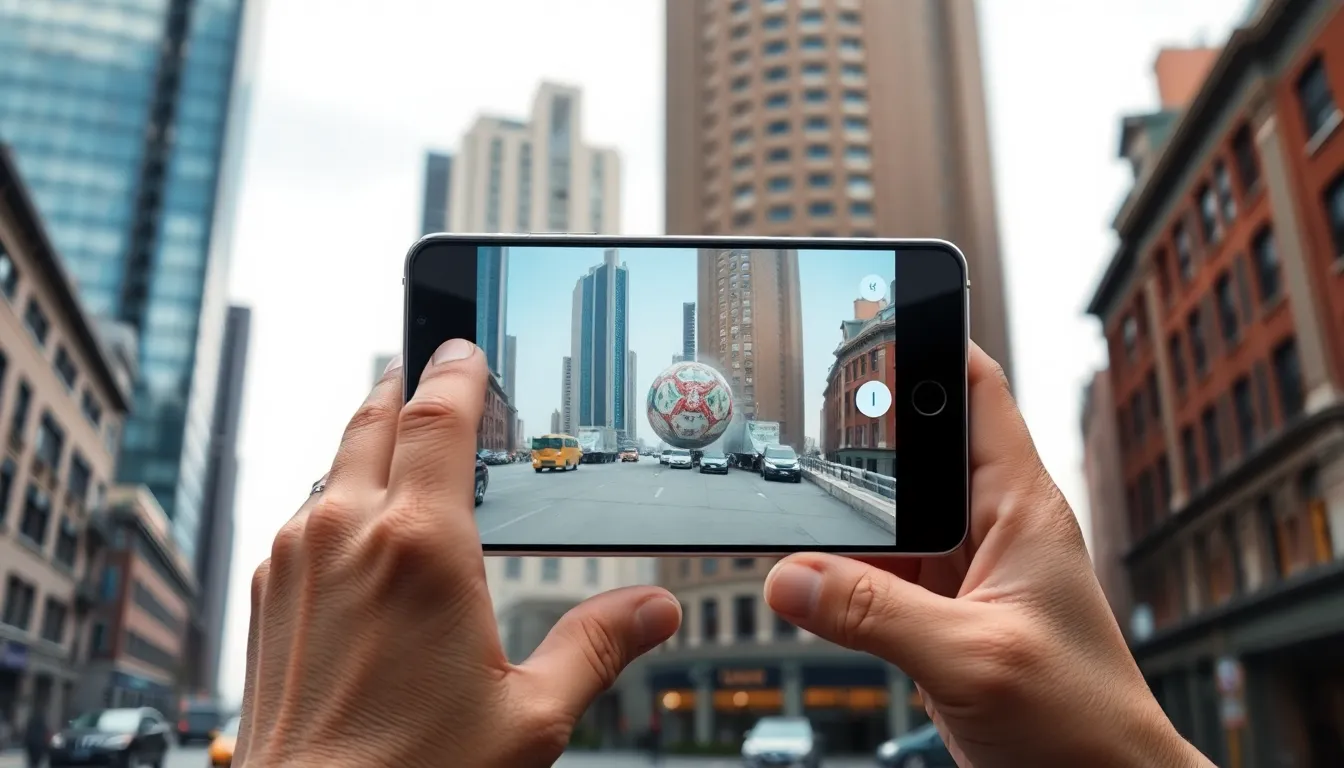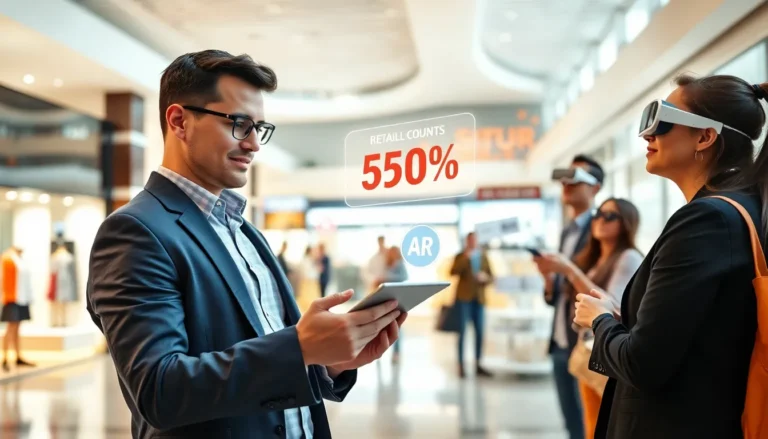Imagine walking down the street and suddenly spotting a dragon perched on a lamppost, or finding a treasure chest buried in your local park. Welcome to the whimsical world of location-based augmented reality (AR), where the ordinary transforms into the extraordinary right before your eyes. This technology blends digital content with the real world, creating experiences that are not just cool but downright magical.
Table of Contents
ToggleOverview of Location-Based AR
Location-based augmented reality (AR) utilizes geographic data to enhance user experiences by overlaying digital components onto real-world locations. Users explore their surroundings through smartphones or AR glasses, encountering digital items relevant to their specific environments. For instance, a user may find historical information about a landmark, animated characters, or interactive game elements at that location.
Smartphones and tablets serve as the primary devices for accessing location-based AR. GPS technology allows these devices to pinpoint exact positions and synchronize digital content accordingly. As a result, AR applications can deliver contextual experiences based on where users stand.
Several notable applications demonstrate the potential of this technology. In gaming, “Pokémon GO” encourages players to capture virtual creatures located at real-world points. Educational apps, like “Google Lens,” provide information about nearby objects, enhancing learning through interaction. Consumers also benefit from AR shopping tools that visualize products in their homes before purchase.
Data indicates a rapid growth in AR market trends. Statista projects the global AR market to reach approximately $198 billion by 2025. Companies increasingly invest in location-based AR to engage customers. Integrating AR into marketing strategies enhances user connections through immersive experiences.
Location-based AR has diverse applications across industries. Retailers utilize it for virtual try-ons, museums enhance exhibits with informational layers, and tourism apps enrich travel with on-the-go guidance. Such versatility illustrates the technology’s potential to redefine engagement and interactivity in everyday life.
Key Technologies Behind Location-Based AR

Location-based AR relies on several key technologies to function effectively. These technologies enhance the user experience by providing contextually relevant digital information overlaying physical environments.
GPS and Navigation Systems
GPS serves as the backbone for location-based AR, enabling devices to determine precise positioning. With accuracy ranging from a few meters to less than one meter, GPS coordinates guide the placement of digital content. Navigation systems facilitate movement through spaces, allowing users to interact with virtual objects seamlessly. Insertion of location data ensures content appears at the right place, enhancing immersion. Devices equipped with GPS receive real-time updates, keeping digital elements aligned with users’ movements. Enhanced positioning systems, such as the Global Navigation Satellite System (GNSS), increase reliability for urban environments where signals can become obfuscated.
Augmented Reality Frameworks
AR frameworks provide essential tools for creating immersive experiences. Popular frameworks, like ARKit and ARCore, enable developers to build applications on iOS and Android platforms. These frameworks simplify the integration of location data with digital content. Tracking abilities help detect surface types and environmental features, allowing accurate overlay of graphics. Built-in functionalities support various applications, from educational tools to gaming experiences. Developers leverage these frameworks to create user-friendly interfaces that enhance interaction. As these technologies evolve, they pave the way for more sophisticated location-based AR experiences.
Applications of Location-Based AR
Location-based AR finds diverse applications across multiple sectors, enhancing user experiences and interactions with the physical world.
Gaming and Entertainment
Gaming and entertainment highly benefit from location-based AR. Pokémon GO exemplifies this, encouraging players to explore real environments while capturing virtual creatures. Players interact with their surroundings, leading to physical activity and social engagement. Other titles, such as Ingress, utilize geolocation to create immersive gameplay tied to actual locations. Users often form teams, enhancing the communal experience. Events like Pokémon GO Fest showcase the potential of AR by activating digital elements at specific venues, drawing in thousands of fans. Overall, gaming experiences leverage the excitement of real-world exploration, merging fun with adventure.
Education and Training
Education and training receive significant enhancements through location-based AR. Interactive learning experiences emerge as students explore historical sites or natural landmarks, accessing additional information through AR applications. Tools like Google Lens provide instant data about objects, facilitating deeper understanding. Museums increasingly adopt AR to overlay interactive exhibits, allowing visitors to engage with their surroundings in dynamic ways. Construction and medical training fields utilize location-based AR for real-world simulations. Faculty can integrate AR into lesson plans, creating engaging educational environments. This technology fosters curiosity and engagement, transforming traditional learning methods.
Retail and Marketing
Retail and marketing thrive with the implementation of location-based AR. Brands leverage this technology to enhance shopping experiences. Virtual try-ons allow customers to visualize products in real-time, increasing confidence in purchases. Companies like Sephora and IKEA utilize AR to showcase items in customer environments, making decision-making easier. Targeted advertising through geolocation draws in consumers based on their proximity to stores, enhancing promotional strategies. Events, such as pop-up shops, may feature AR elements to attract attention and engage shoppers. Overall, retailers can create memorable experiences that convert visits into sales, enhancing profitability in competitive markets.
Challenges and Limitations
Location-based augmented reality faces several challenges that can hinder user experience and widespread adoption. Accuracy and reliability issues constitute primary concerns.
Accuracy and Reliability
Location precision directly influences user experience in location-based AR. In urban environments, GPS signals may become weak or obstructed, causing inaccuracies in digital content placement. Enhanced positioning systems like GNSS aim to address these problems, yet factors like tall buildings or dense foliage can still disrupt signals. Users might experience mismatches between physical locations and digital overlays, leading to frustration. Developers must ensure accurate data integration to enhance user confidence in the technology. The continuous evolution of AR frameworks supports improvements in reliability, but inconsistencies remain a significant hurdle for developers and users alike.
Privacy Concerns
Privacy concerns pose another significant challenge for location-based AR. Users often share their real-time location data to access augmented experiences. This raises questions about how this information is stored, used, and potentially misused. Companies collecting location data could inadvertently expose sensitive user information through data breaches. Additionally, unwanted surveillance could occur with pervasive location tracking. Users might hesitate to adopt location-based AR out of fear of privacy violations. Developers and companies must prioritize user consent and data protection measures to foster trust and secure wider adoption.
Future Trends in Location-Based AR
Location-based augmented reality continues to evolve, showcasing a bright future enriched by advancements and adoption across various sectors.
Enhancements in Technology
Improvements in GPS technology boost accuracy, enabling precise tracking in complex urban environments. Developers utilize advanced frameworks like ARKit and ARCore to enhance user experiences, integrating location data seamlessly with digital overlays. Enhanced positioning systems, such as the Global Navigation Satellite System, further refine accuracy and reliability. As these technologies advance, they promise to make AR experiences more immersive and engaging. Increased computational power in devices allows for richer graphics and interactions, elevating user experiences significantly.
Broader Adoption Across Industries
Growing interest in location-based AR spans multiple sectors, including retail, education, and tourism. Retailers leverage AR to create personalized experiences through virtual try-ons, enhancing customer engagement and driving sales. Educational institutions incorporate AR technology, providing interactive learning experiences at historical sites and museums, fostering deeper connections with content. Tourism companies adopt AR to offer enriched journeys, helping travelers discover local culture and history through engaging overlays. Enhanced accessibility to the technology further drives adoption, as more users begin exploring these innovative applications.
Location-based AR is set to redefine how people interact with their surroundings. By seamlessly blending digital content with the physical world, it offers unique experiences that engage users in ways previously unimaginable. As technology continues to advance, the potential for enhanced accuracy and immersive applications grows.
Industries across the board are beginning to recognize the value of location-based AR. From gaming to education and retail, the possibilities are vast and exciting. As challenges like GPS reliability and privacy concerns are addressed, broader adoption is likely to follow.
The future of location-based AR looks promising, with innovative applications on the horizon. This technology is not just a trend; it’s a game-changer that will continue to shape user experiences and interactions in everyday life.









